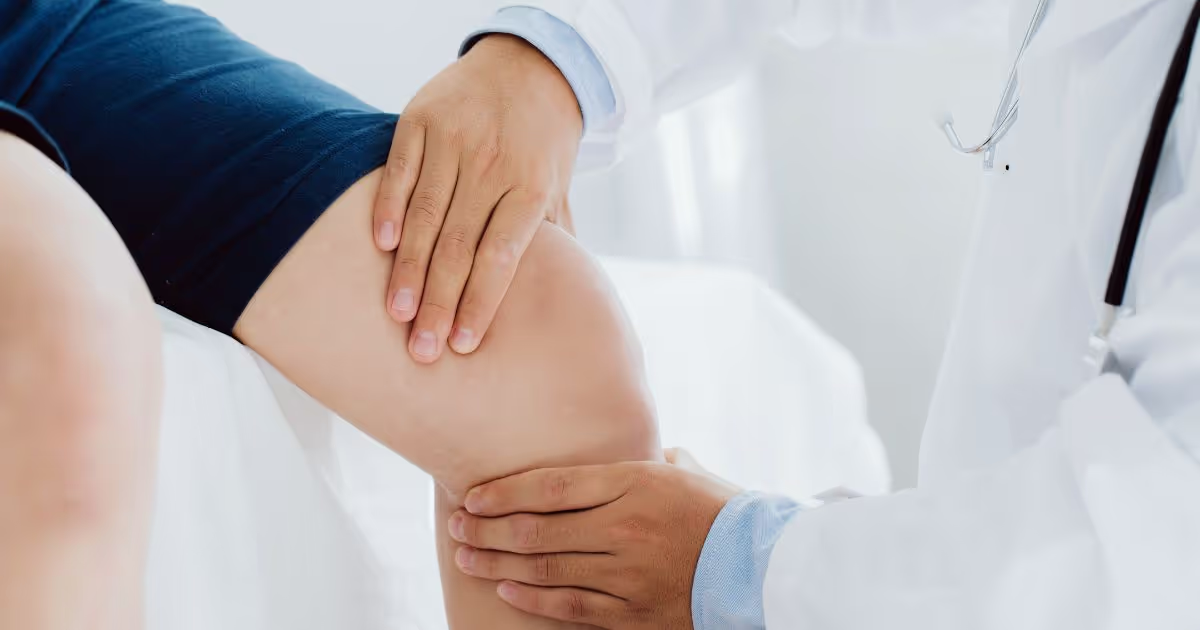Choose the content to read
- What conditions does ACL reconstruction treat?
- Indications for ACL reconstruction
- What is the ACL reconstruction procedure?
- What is the recovery time of ACL reconstruction?
- What is the complication of ACL reconstruction?
- What are the benefits of ACL reconstruction?
ACL reconstruction
ACL reconstruction is a minimally invasive surgical procedure to repair a torn anterior cruciate ligament (ACL) and replace the damaged ligament with a graft taken from another part of the body to eliminate knee pain, knee swelling, loose knees, knee noise, and the inability to extend and flex the knee normally due to sports injuries, traffic accidents, or tumbles and falls, causing the knee to severely twist and resulting in the anterior cruciate ligament tearing. ACL reconstruction repairs a torn ACL, a torn meniscus, or knee joint instability, restoring full-functioning ACL, enhancing strength and stability to the knee joint, and enabling the knee to stretch and bend, as well as walking, running, and playing sports at the previous performance.
Why ACL reconstruction?
ACL tear caused by severe impact during sports, a sudden stop while running, a sudden change of direction, severe jumping up and down, or accidental tumbles and falls causes the knee joint to twist inward, resulting in inflammation of the knee joint, cartilage, and surrounding tissues, leading to severe knee pain, bleeding in the knee joint, a popping sound in the knee joint, knee swelling, a loose knee joint, and a collapsed knee joint, making it impossible to engage in sports, walk or run, or put full weight on the feet, resulting in premature knee joint degeneration and the risk of chronic osteoarthritis.
ACL reconstruction is performed using a minimally invasive arthroscopic technique with high-definition lenses and fiber optics, displaying real-time details inside the knee joint on an external monitor screen to allow the orthopedic surgeon to operate on a torn ACL from within the knee joint, enabling smaller surgical incisions, less blood loss, less tissue damage, fewer complications, and a shorter recovery period while rebuilding the ACL to its full range of extension and flexion motions, allowing full-weight-bearing walking and running, as well as aiding in the restoration of full athletic performance.
What conditions does ACL reconstruction treat?
- Anterior cruciate ligament (ACL) tears are caused by direct or indirect impact, changes in rotational direction, or sudden acceleration or deceleration, causing ACL tears due to knee hyperextension, severe acute knee pain, a popping sound in the knee joint, bleeding into the knee joint, inability to continue playing sports, knee swelling, walking with a limp, and inability to put full weight on the foot.
- Meniscus tears are caused by severe or incorrect knee rotation, which presses the knee joint against the cartilage. The meniscus becomes stuck between the joints, causing joint pain, a popping sound in the joint, an inability to fully extend the knee, a locked knee, knee instability, and an inability to put full weight on the foot. This results in eroded cartilage and the risk of osteoarthritis.
- Loose knee joint caused by a tear of the anterior cruciate ligament (ACL) while putting weight on the leg and knee or by a severe twisting motion, resulting in knee pain, knee swelling, loose knee, dislocation of the tibia (shin bone) forward, feeling like the knee joint is moving apart when twisting the leg, walking with a limb, inability to run in a zigzag, failure to stop suddenly while running, and inability to play sports at the same performance as before.
Indications for ACL reconstruction
- Severe knee pain, swelling, and bruising within a few hours
- A popping sound in the knee, knee noise when moving
- Forward dislocated knee, knee dislocated when twisting the leg
- Weaknesses of the knee and leg when walking, running, or playing sports
- Knee pain when running, limping, inability to put weight on the foot
- Degenerative knee joint, loose knee, loss of knee stability.
- Difficulty extending and flexing, severe knee pain while squatting
- Medication treatment or physical therapy does not improve
- Athletes who want to regain their full athletic performance
What is the diagnosis before ACL reconstruction?
The orthopedist will diagnose an ACL tear by inquiring if there is severe knee pain, knee swelling, or knee looseness, including observing if walking with a limp, range of walking, weight bearing on the foot, knee extension range compared to the opposite leg, history of underlying diseases, and history of medications that don’t improve, followed by medical imaging of the knee joint on the anterior, lateral, and posterior, as follows:
- X-rays examine the structure of the knee joint, the proximal part of the tibia, the distal part of the femur, the patella, and the cartilage between the knee joints.
- CT scan examines the structure of the knee joint, meniscus, cartilage, fibrous connective tissues, surrounding tissue, and ligaments, looking for a torn anterior cruciate ligament, a dislocated knee, collapsed bones, or infection.
- MRI examines the structure of the knee joint and cartilage in 3D, looking for a torn anterior cruciate ligament, a torn meniscus, intraarticular fractures, a dislocated knee, bone spurs, or deformed bones.
What is the ACL reconstruction procedure?
ACL reconstruction procedure at MedPark Hospital adopts the international gold standard in surgery, prioritizing safety and treatment success outcomes to achieve the treatment goal of rebuilding a torn ACL, restoring strength and stability to the knee joint, eliminating knee pain, and allowing the patient to walk, run, and play sports at full performance as before.
Preoperative ACL reconstruction
- Before surgery, the orthopedist will advise you to work with a physical therapist to help stretch and bend the knee fully due to the torn anterior cruciate ligament, causing swelling, bruising, stiffness, and limited body movement. Muscle training will help you achieve the best possible surgical outcomes.
- Stop taking antiplatelets such as aspirin, naproxen, Plavix, or NSAIDs for at least 1 week before surgery. Those who have underlying diseases or a history of drug allergies *must* notify the doctor in advance.
- Stop eating and drinking at least 6 hours before surgery and abstain from drinking alcohol at least 24 hours before surgery.
Intraoperative ACL reconstruction
- The anesthetist will administer general anesthesia to numb the sensations. The orthopedic surgeon will perform an ACL reconstruction by making 2 keyhole incisions of 1-1.5 cm, both on the left and right sides: 1 incision for inserting a high-definition arthroscope, which allows the orthopedic surgeon to see the details inside the knee joint, including the anterior cruciate ligament, posterior cruciate ligament, meniscus, cartilage, and surrounding tissues, and 1 incision for inserting medical instruments to repair the damaged parts.
- The orthopedic surgeon injects saline into the knee joint to expand the surgical space surrounding the joint. The arthroscope and surgical instruments will then be inserted to repair and restore the torn meniscus, cartilage, or tissues to normal condition. A tendon from other body parts, e.g., the patellar or hamstring tendons, will be selected as a graft to repair a torn ACL.
- The orthopedic surgeon makes a 3 cm incision at the front of the knee at the ACL attachment point to remove the torn ACL and drills a small hole at the distal end of the femur and the proximal part of the tibia at the appropriate attachment point. The harvested graft is then threaded through the drilled hole, and screws are inserted to secure both ends of the new ACL, enabling the proper range of extension and flexion motion.
- The orthopedic surgeon inspects the attachment point, tightness, and looseness of an ACL graft, as well as the meniscus and the surrounding tissue, to ensure it fits properly and meets the angle values in the proper range of extension and flexion to achieve the best possible knee function before cleaning and stitching the surgical incisions. Typically, ACL reconstruction takes approximately 1-2 hours.
Postoperative ACL reconstruction
- The orthopedic surgeon will transfer the patient to the recovery room for close monitoring and slightly elevate the patient's legs above the heart level to reduce swelling.
- The surgeon will wrap a bandage around the knee to apply pressure to the incision and reduce blood vessel expansion and swelling.
- For the first 24-48 hours after surgery, physical therapists or medical professionals will assist the patient on how to walk with crutches.
What is ACL reconstruction aftercare?
- Take painkillers continuously as prescribed by the orthopedist. If you experience severe pain, dizziness, nausea, or bleeding, seek medical attention at the hospital right away.
- Follow the R-I-C-E principle: rest in a comfortable position, apply cold compresses, press direct pressure on the knee with a bandage, and elevate your leg.
- The orthopedist will schedule appointments with a physical therapist to practice walking starting 2-3 days after surgery to help strengthen your knee joint.
- Refrain from strenuous activities, heavy exercise, or heavy lifting for 4-6 months, depending on each individual's strength.
What is the recovery time of ACL reconstruction?
Typically, patients who have undergone ACL reconstruction will gradually recover over 6–9 months. They will be able to walk briskly in 3-6 months, stand and twist their hips in 6-8 months, and engage in or compete in football, American football, badminton, basketball, or volleyball in 9-12 months. However, this is dependent on each individual's physical strength and physical therapy training to increase muscle strength, as advised by the orthopedist.
What is the complication of ACL reconstruction?
Common complications from ACL reconstruction include swelling and pain at the surgical site, harvested ACL graft tears, stiffness, infection, or numbness from nerve damage. However, the occurrence of these complications is low. Typically, ACL reconstruction is regarded as a safe and highly effective treatment for anterior cruciate ligament (ACL) tears.
What is the success rate of ACL reconstruction?
Postoperative ACL reconstruction has a high success rate of 80–97%. Orthopedic surgeons can successfully reconstruct the anterior cruciate ligament, and knee pain gradually subsides until full recovery. Additionally, patients can fully extend and flex their knees. They can walk and run with normal weight-bearing as well as play sports they used to play with their full functioning. Approximately 90–95% of those who have undergone ACL reconstruction surgery can regain their sports performance to their previous level.
What are the benefits of ACL reconstruction?
- Capable of resuming sports and activities at the same level as before the injury
- Prevent the risk of other knee ligament tears, loose knees, collapsed knees, or osteoarthritis.
- MIS technique, small incisions, less pain, quick recovery, and can reconstruct a new ACL precisely.
- Less blood loss, less tissue damage, less risk of infection, and less post-operative joint stiffness than open surgery.
- Short hospital stays of only 1-2 days allow patients to quickly return home to continue their at-home recovery. The anterior cruciate ligament (ACL) and muscles recover quickly.
ACL reconstruction at MedPark Hospital
Orthopedic Center, MedPark Hospital, Bangkok, Thailand, led by a team of seasoned orthopedic surgeons at the professor level with extensive experience in operations both domestically and internationally, is ready to diagnose and treat complex torn anterior cruciate ligament (ACL), torn meniscus, or knee joint instability with ACL reconstruction surgery, using state-of-the-art medical technology, integrated with advanced surgical techniques, enabling fast, precise, and safe, resulting in the most treatment efficacy while providing constant post-operative aftercare to speed up the recovery of bones, muscles, and joint systems, reduce complications and allow patients to resume their beloved sports, activities, and daily life as soon as possible.







